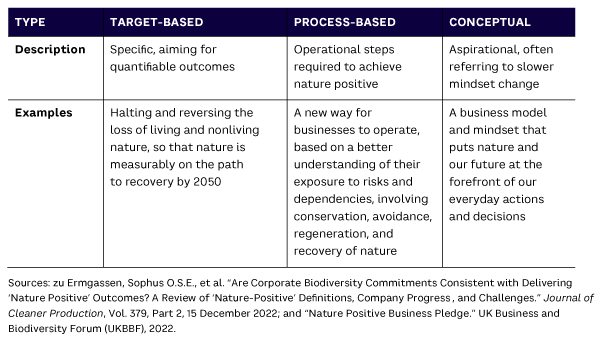Most of us are familiar with the “net zero” concept; we now have “nature positive” added to the mix. What net zero has done for the climate crisis, nature positive aims to do with our nature and biodiversity emergency. Initiatives including the “Global Goal for Nature,” “Get Nature Positive,” and “Nature Positive 2030” have adopted this term to demonstrate their ambition to improve the current state of nature; consultancies are providing nature positive services to their clients; and news outlets are using the term in articles. Amidst all this, organizations are grappling with developing a consistent, rigorous definition of nature positive.
Defining Nature Positive
Evolution of the Term
At its core, nature positive stems from the idea of “no net loss,” which was introduced in public pollution and wetland environmental trading in the US in the 1970s. It established the concept of compensating for environmental goods and services that were previously removed from the environment and paved the way for “net positive impact”: not just compensating but adding value to the environment that was lost.
Over the years, these concepts have been refined by international organizations into a suite of well-respected methods. These include International Finance Corporation’s Performance Standard 6, World Bank’s Environmental and Social (ESS) Standard 6, and Business and Biodiversity Offsets Programme’s (BBOP) guidance, which set out standards, principles, and/or approaches for delivering no net loss or net gain in biodiversity. In the UK, this idea entered into national legislation through Environment Act 2021 requiring all new developments to achieve biodiversity net gain, which it describes as an approach to development that leaves biodiversity in a measurable better state than before.
As articulated by Professor E.J. Milner-Gulland, the key to these concepts is the idea of “net”: that the overall impacts of an activity, after summing up all individual impacts since the baseline was established, reach a predefined balance (i.e., no loss or gain). Implicitly, however, it acknowledges that negative anthropogenic impacts on nature cannot cease in their entirety and that that portion will need to be compensated for.
This has shaped the business narrative around nature in fundamental ways. First, it encourages quantifiable measuring of impacts that can be summarized and analyzed the way other business-related risks and opportunities are framed. Second, if the BBOP’s good practice principles are not followed, it sets up the idea of inevitable loss, potentially leading to a lack of ambition and business-as-usual-with-offsetting scenario.
The term “nature positive” began appearing in common discourse in 2020.1 A recent paper suggested the term’s popularity stems from: (1) a growing recognition of the economic and financial risks of biodiversity loss and (2) the pervasiveness of biodiversity impact across the value chain.
Its popularity can also be explained by its increased inclusivity. Nature encompasses all elements of the natural environment, recognizing the interdependence of abiotic (e.g., water, air, minerals, temperature) and biotic (e.g., biodiversity of all living things, including terrestrial, freshwater, marine, and soil biodiversity) elements. The word “positive” is a symbolic, resonant term that engages the general public and avoids technical jargon. We must remember that the way nature positive is defined will have significant influence on how businesses address their nature-related activities.
A Coherent Definition
With the rising popularity of the term “nature positive,” it’s important to set a singular, clear definition. Such high-level terms can become vulnerable to deviations in and loss of meaning.
Current definitions can be broadly categorized into three types: target-based, process-based, and conceptual (see Table 1). Each type covers an important aspect of achieving nature positive, but there is a need to ensure rigor. This can be done by mentioning measurability, a baseline, a time frame, and a quantifiable target that will allow for clear action, reporting, monitoring, and disclosure of progress. The “Global Goal for Nature” initiative provides such a definition:
We need to halt and reverse nature loss measured from a baseline of 2020, through increasing the health, abundance, diversity, and resilience of species, populations, and ecosystems so that by 2030 nature is visibly and measurably on the path of recovery.

This definition sets out clear parameters for the delivery of nature positive and implicitly carries the concepts around a net balance and inclusivity. However, there are some issues to point out. A 2020 baseline is not appropriate for organizations that were set up after 2020 or with ongoing landholding or range-of-work changes that occur after 2020. In addition, these targets do not mention people and society. Although nature positive’s aim is to improve the state of nature, it must be carried out in a way that does not negatively impact people and society and, where possible, synergistically benefits both. If this concept cannot be embedded in the definition of nature positive itself, it must be included in a wider set of principles that supports it.
Note
1Based on search of the term on Google Trends; a score value of 50, defined as half-popular by the system, was chosen as the point at which the term enters common discourse.
[For more from the authors on this topic, see: “The Path Toward a Nature Positive Business.”]




